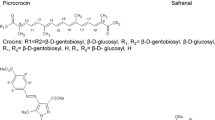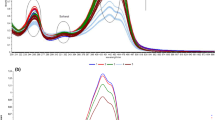Abstract
In this study, a spectroscopic method was developed for the determination and quantification of saffron adulteration with some plant adulterants (safflower, marigold, and turmeric). For this purpose, three spectroscopic techniques, namely, attenuated total reflectance Fourier transform infrared (ATR-FTIR) spectroscopy, Raman spectroscopy, and laser-induced breakdown spectroscopy (LIBS), were applied, and the superiority of the techniques was investigated by using principal component analysis (PCA). All spectral data were compared, and the best discrimination among saffron and plant adulterants was obtained with LIBS according to PCA results. Following this analysis, partial least squares (PLS) method was carried out using LIBS data to reveal the level of plant adulteration in saffron samples. A good linearity was obtained with a coefficient of determination (R 2) values of 0.999 for calibration and cross-validation in the range of 10–50% with a limit of detection (LOD) and quantification (LOQ) of 1.86 and 9.32%, respectively. Taking the results into consideration, it was seen that the LIBS technique combined with PLS provides a sensitive determination of plant adulterants in saffron under 10%, which is difficult to detect using the reference UV-Vis spectroscopic method.






Similar content being viewed by others
References
Anastasaki E, Kanakis C, Pappas C, Maggi L, del Campo CP, Carmona M, Alonso GL, Polissiou MG (2010a) Differentiation of saffron from four countries by mid-infrared spectroscopy and multivariate analysis. Eur Food Res Technol 230:571–577
Anastasaki EG, Kanakis CD, Pappas C, Maggi L, Zalacain A, Carmona M, Alonso GL, Polissiou MG (2010b) Quantification of crocetin esters in saffron (Crocus sativus L.) using Raman spectroscopy and chemometrics. J Agric Food Chem 58:6011–6017
Babaei S, Talebi M, Bahar M (2014) Developing an SCAR and ITS reliable multiplex PCR-based assay for safflower adulterant detection in saffron samples. Food Control 35(1):323–328
Bich VT, Thuy NT, Binh NT, Huong NTi M., Yen PND, Luong TT (2009) In Physics and engineering of new materials. Cat DT, Pucci A, Wandelt K (Eds.), Springer, Berlin Heidelberg
Bilge G, Boyaci IH, Eseller KE, Tamer U, Cakir S (2015) Analysis of bakery products by laser-induced breakdown spectroscopy. Food Chem 181:186–190
Bunghez IR, Ion RM (2011) Complex spectral characterization of active principles from marigold (Calendula officinalis). Journal of Science and Arts 14:59–64
Burgio L, Clark RJH (2001) Library of FT-Raman spectra of pigments, minerals, pigment media and varnishes, and supplement to existing library of Raman spectra of pigments with visible excitation. Spectrochim. Acta. Part A 57:1491–1521
Carmona M, Zalacain A, Salinas MR, Alonso GL (2007) New approach to saffron aroma. Crit Rev Food Sci Nutr 47:145–159
Cho MH, Paik YS, Hahn TR (2000) Enzymatic conversion of precarthamin to carthamin by a purified enzyme from the yellow petals of safflower. J Agric Food Chem 48(9):3917–3921
Ferreira EC, Menezes EA, Matos WO, Milori DMBP, Nogueira ARA, Martin-Neto L (2010) Determination of Ca in breakfast cereals by laser induced breakdown spectroscopy. Food Control 21:1327–1330
García-Rodríguez MV, Serrano-Díaz J, Tarantilis PA, López-Córcoles H, Carmona M, Alonso GL (2014) Determination of saffron quality by high-performance liquid chromatography. J Agric Food Chem 62(32):8068–8074
Giaccio M (2004) Crocetin from saffron: an active component of an ancient spice. Crit Rev Food Sci Nutr 44:155–172
Hagh-Nazari S, Keifi N (2006) Saffron and various fraud manners in its production and trades. II. International Symposium on Saffron Biology and Technology, 739
Hamzaoui S, Khleifia R, Jaïdane N, Lakhdar ZB (2011) Quantitative analysis of pathological nails using laser-induced breakdown spectroscopy (LIBS) technique. Lasers Med Sci 26:79–83
Heidarbeigi K, Mohtasebia SS, Foroughirada A, Ghasemi-Varnamkhastic M, Rafieea S, Rezaeid K (2015) Detection of adulteration in saffron samples using electronic nose. Int J Food Prop 18:1391–1401
ISO 3632-1 Technical Specification. Saffron (Crocus sativus L.) Part 1 (specification) (2011) Geneva, Switzerland: International Organization for Standardization
ISO 3632-2 Technical Specification. Saffron (Crocus sativus L.) Part 2 (test methods) (2010) Geneva, Switzerland: International Organization for Standardization
Jadhav B, Joshi A (2015) Extraction and quantitative estimation of bio active component (yellow and red carthamin) from dried safflower petals. Indian Journal of Science and Technology 8(16)
Lage M, Cantrell CL (2009) Quantification of saffron (Crocus sativus L.) metabolites crocins, picrocrocin and safranal for quality determination of the spice grown under different environmental Moroccan conditions. Sci Hortic 121:366–373
Lee FY, Htar TT, Akowuah GA (2015) ATR-FTIR and spectrometric methods for the assay of crocin in commercial saffron spices (Crocus savitus L.). Int J Food Prop 18:1773–1783
Maggi L, Sánchez AM, Carmona M, Kanakis CD, Anastasaki E, Tarantilis PA, Polissiou MG, Alonso GL (2011a) Rapid determination of safranal in the quality control of saffron spice (Crocus sativus L.). Food Chem 127:369–373
Maggi L, Carmona M, Kelly SD, Marigheto N, Alonso GL (2011b) Geographical origin differentiation of saffron spice (Crocus sativus L. stigmas)—preliminary investigation using chemical and multi-element (H, C, N) stable isotope analysis. Food Chem 128:543–548
Marieschi M, Torelli A, Bruni R (2012) Quality control of saffron (Crocus sativus L.): development of SCAR markers for the detection of plant adulterants used as bulking agents. J Agric Food Chem 60(44):10998–11004
Melnyk JP, Wang S, Marcone MF (2010) Chemical and biological properties of the world's most expensive spice: saffron. Food Res Int 43:1981–1989
Mohan PRK, Sreelakshmi G, Muraleedharan CV, Joseph R (2012) Water soluble complexes of curcumin with cyclodextrins: characterization by FT-Raman spectroscopy. Vib Spectrosc 62:77–84
Ordoudi SA, De los Mozos Pascual M, Tsimidou MZ (2014) On the quality control of traded saffron by means of transmission Fourier-transform mid-infrared (FT-MIR) spectroscopy and chemometrics. Food Chem 150:414–421
Petrakis EA, Cagliani LR, Polissiou MG, Consonni R (2015) Evaluation of saffron (Crocus sativus L.) adulteration with plant adulterants by (1)H NMR metabolite fingerprinting. Food Chem 173:890–896
Rigane G, Ben Younes S, Ghazghazi H, Ben Salem R (2013) Investigation into the biological activities and chemical composition of Calendula officinalis L. growing in Tunisia. Int Food Res J 20(6):3001–3007
Sabatino L, Scordino M, Gargano M, Belligno A, Traulo P, Gagliano G (2011) HPLC/PDA/ESI-MS evaluation of saffron (Crocus sativus L.) adulteration. Nat Prod Commun 6(12):1873–1876
Sánchez AM, Carmona M, Zalacain A, Carot JM, Jabaloyes JM, Alonso GL (2008) Rapid determination of crocetin esters and picrocrocin from saffron spice (Crocus sativus L.) using UV–visible spectrophotometry for quality control. J Agric Food Chem 56:3167–3175
Silvestre DM, Barbosa FM, Aguiar BT, Leme FO, Nomura CS (2015) Feasibility study of calibration strategy for direct quantitative measurement of K and Mg in plant material by laser-induced breakdown spectrometry. Anal Chem Res 5:28–33
Tarantilis PA, Beljebbar A, Manfait M, Polissiou M (1998) FT-IR, FT-Raman spectroscopic study of carotenoids from saffron (Crocus sativus L.) and some derivatives. Spectrochim. Acta. Part A 54:651–657
Tiwari M, Agrawal R, Pathak AK, Rai AK, Rai GK (2013) Laser-induced breakdown spectroscopy: an approach to detect adulteration in turmeric. Spectrosc Lett: An International Journal for Rapid Communication 46(3):155–159
Wise BM, Gallagher NB, Bro R, Shaver JM, Windig W, Koch RS (2014) PLS_Toolbox 7.5.2 for use with MATLAB., Eigenvector Research Inc., Wenatchee
Yoon JM, Cho MH, Park JE, Kim YH, Hahn TR, Paik YS (2003) Thermal stability of the pigments hydroxysafflor yellow A, safflor yellow B, and precarthamin from safflower (Carthamus tinctorius). J Food Sci 68(3):839–843
Zalacain A, Ordoudi SA, Díaz-Plaza EM, Carmona M, Blázquez I, Tsimidou MZ, Alonso GL (2005) Near-infrared spectroscopy in saffron quality control: determination of chemical composition and geographical origin. J Agric Food Chem 53(24):9337–9341
Acknowledgments
The authors thank Banu Sezer (Department of Food Engineering, Hacettepe University) for her help during LIBS analysis of samples.
Author information
Authors and Affiliations
Corresponding author
Ethics declarations
Conflict of Interest
Suzan Varliklioz Er declares that she has no conflict of interest. Haslet Eksi-Kocak declares that she has no conflict of interest. Hasan Yetim declares that he has no conflict of interest. Ismail Hakki Boyaci declares that he has no conflict of interest.
Ethical Approval
This article does not contain any studies with human participants or animals performed by any of the authors.
Informed Consent
Not applicable.
Electronic supplementary material
ESM 1
(DOCX 446 kb)
Rights and permissions
About this article
Cite this article
Varliklioz Er, S., Eksi-Kocak, H., Yetim, H. et al. Novel Spectroscopic Method for Determination and Quantification of Saffron Adulteration. Food Anal. Methods 10, 1547–1555 (2017). https://doi.org/10.1007/s12161-016-0710-4
Received:
Accepted:
Published:
Issue Date:
DOI: https://doi.org/10.1007/s12161-016-0710-4




